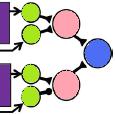I have places for a limited number of undergraduates to do their third-year projects in my lab. While it would be possible for a suitably skilled student to a do a computational neuroscience project, most students within the Faculty of Medical Sciences will probably lack the requisite programming skills, and thus prefer to do a project on visual psychophysics. This will usually involve taking pilot data for a study on stereoscopic processing. Because of the limited time, I would expect to program the visual stimuli and data collection. Most of the students’ time would be spent actually collecting psychophysical data from themselves and other students. This involves sitting in a dark room, with your head supported in a head rest, looking at large numbers of abstract black-and-white images presented one after another on a screen. For each image, you would press a mouse button to answer a simple question, for instance (in a motion study) whether the image was moving left or right, or to say whether part of the image appeared in front of or behind the screen.
Many projects in my lab will involve a 3D display. These cause an illusion of depth by presenting different images to the two eyes. I have several 3D displays in my lab, depending on the particular needs of each project. For example, I have 3D computer monitors and a 3D television. I also have a two-projector system which presents a large 3D image on a projector screen.
Using 3D displays, we can mimic the small differences — called disparities — between the two eyes’ views which arise in natural viewing. This gives a compelling illusion of depth, which you have probably experienced in an IMAX cinema or similar. However, it’s often more informative in vision research to construct stimuli which could never occur in real life. For example, people have studied what happens when one eye’s image is replaced with its photographic negative, or when one eye views vertical lines and the other views horizontal. Studying what the brain sees when presented with such images can give us information about how the brain extracts depth in normal images.
For this purpose, it’s important to carry out very precise measurements of exactly how much depth is perceived. When the depth perception is very weak or non-existent, subjects who are forced to say whether the image appears in front of or behind the screen will answer “in front” half of the time and “behind” half the time; in other words, they are performing at chance. As the image gets stronger, they will start to answer “in front” (say) more and more, until eventually they always see it in front. One common psychophysical task is to measure how much you need to shift the left and right eye’s images relative to one another until subjects give consistent answers 75% of the time. In this way, we are able to give a precise quantitative meaning to terms like a “weak” perception of depth.
See the projects booklet for more details of specific projects; explore this site for more details about who I am and what I do.
Summer projects
There are also some potential sources of funding for students wishing to work in my lab over the summer vacation. Please feel free to research these, see if any are relevant to you, and get in touch to discuss how to take it further. These usually have closing dates in February or March of the year in question, so do get started early!
- Nuffield Foundation Undergraduate Research Bursaries in Science
- Experimental Psychology Society Undergraduate Research Bursaries
- Physiological Society Undergraduate Vacation Studentship Scheme
- Wellcome Trust Biomedical Science Vacation Scholarships. I was awarded one of these in 2010.
- Newcastle University Vacation Scholarships scheme.



















